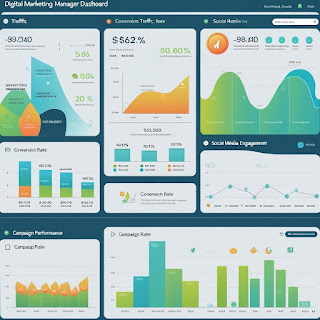A Digital Marketing Manager’s Dashboard is a centralized visual interface that provides real-time access to key metrics and performance indicators across various marketing channels. It helps digital marketers monitor campaigns, track ROI, analyze audience behavior, and make data-driven decisions—all in one place. Think of it as a control room that gives a bird’s-eye view of the digital marketing landscape.
-
Traffic Sources
-
Shows how users find your website (organic search, paid ads, social media, email, direct traffic).
-
Helps assess the effectiveness of each channel.
-
-
Website Analytics
-
Bounce rate, session duration, pages per session.
-
Key for evaluating user experience and content performance.
-
-
Conversion Metrics
-
Goal completions, leads generated, conversion rate, cost per conversion.
-
Essential for measuring campaign success.
-
-
Campaign Performance
-
CTR (Click-through rate), impressions, CPC (Cost-per-click).
-
Displays paid ad campaign insights from platforms like Google Ads or Meta Ads.
-
-
Social Media Analytics
-
Engagement rate, reach, followers, shares, comments.
-
Indicates brand visibility and audience interaction across platforms.
-
-
Email Marketing Performance
-
Open rate, click-through rate, unsubscribe rate.
-
Helps refine communication strategy and content relevance.
-
-
SEO Insights
-
Keyword rankings, backlinks, domain authority.
-
Vital for organic search strategy and content optimization.
-
-
Revenue and ROI Tracking
-
Tracks total revenue generated from campaigns, ad spend, and overall ROI.
-
Critical for budget allocation and performance optimization.
-
Types of Marketing Dashboards
-
Real-Time Dashboards
-
Updates instantly to show current performance data.
-
Best for live campaigns and quick adjustments.
-
-
Executive Dashboards
-
Summarized high-level KPIs for C-suite stakeholders.
-
Focus on ROI, revenue, and growth trends.
-
-
Channel-Specific Dashboards
-
Dedicated to one platform like Google Ads, LinkedIn, or Instagram.
-
Useful for granular analysis and platform strategy.
-
-
Campaign Dashboards
-
Tailored for specific marketing campaigns or product launches.
-
Tracks campaign-specific KPIs like conversions and CTRs.
-



.png)

Comments
Post a Comment